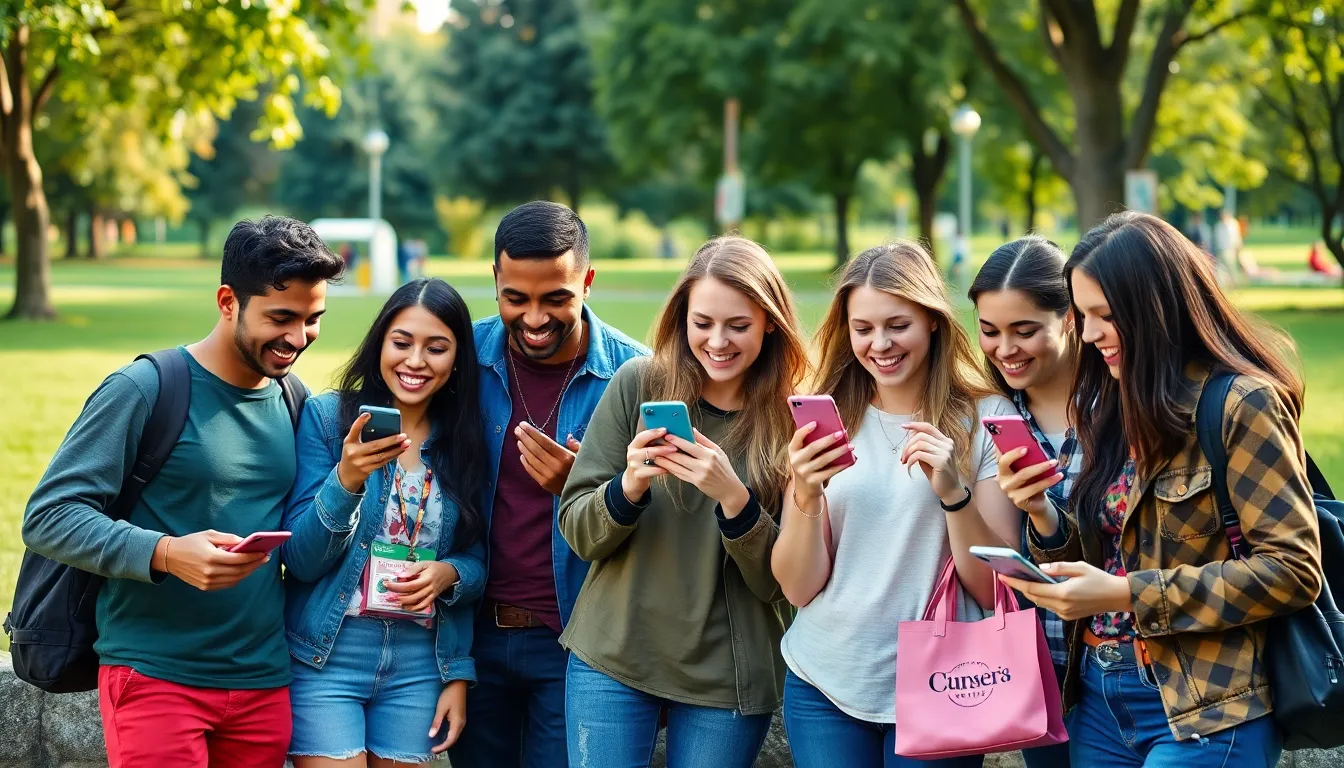In today’s digital jungle, brands are fighting tooth and nail for consumer attention. Enter social media loyalty programs—the secret sauce that can turn casual scrollers into die-hard fans. Imagine a world where liking a post or sharing a meme earns rewards. Sounds dreamy, right? It’s not just a fantasy; it’s a savvy strategy that keeps customers coming back for more.
These programs not only boost engagement but also create a community around a brand. Who wouldn’t want to be part of an exclusive club that offers perks for simply being social? As companies harness the power of likes and shares, they’re transforming the way loyalty works. So buckle up as we dive into the quirky world of social media loyalty programs, where every click could lead to sweet rewards.
Table of Contents
ToggleOverview of Social Media Loyalty Programs
Social media loyalty programs leverage user engagement to strengthen brand loyalty. Brands reward customers for participating in activities like sharing content or commenting on posts. Such incentives transform casual users into dedicated advocates.
Various platforms host these programs, including Facebook, Instagram, and Twitter. Each platform offers unique features that enhance community building. Companies often create exclusive content for participants, fostering a deeper connection with the brand.
Consumer data shows that brands with loyalty programs see higher engagement rates. In fact, businesses report a 20% increase in customer retention through social media initiatives. Community-oriented approaches make users feel valued, driving them to actively participate in brand-related conversations.
Gamification elements also play a key role. Brands utilize challenges or contests to encourage participation. Users earn points or badges, integrating a fun aspect into loyalty building. As a result, social media interactions surge, boosting brand visibility.
Understanding metrics is crucial in evaluating the effectiveness of these programs. Engagement rates, conversion statistics, and customer feedback provide insights into success. Companies often adjust strategies based on these data points to maximize program effectiveness.
Ultimately, social media loyalty programs cultivate a vibrant community. As businesses embrace this innovative approach, consumers engage more meaningfully with brands.
Benefits of Social Media Loyalty Programs

Social media loyalty programs offer businesses a range of advantages, turning casual users into dedicated supporters. Engaging customers through these programs leads to significant benefits.
Enhanced Customer Engagement
Engagement levels soar when brands implement loyalty programs on social media. Users interact more frequently with content by sharing posts or participating in challenges. In fact, businesses reporting a 20% increase in customer retention find that rewards for participation encourage more interactions. Customers enjoy feeling recognized for their loyalty, fostering a connection with brands. This dynamic atmosphere cultivates a vibrant community, making followers feel valued and involved. As brands adapt their strategies based on metrics and feedback, they further enhance engagement through tailored experiences.
Increased Brand Awareness
Brand awareness rises significantly with social media loyalty programs. When customers share their experiences or engage with posts, they effectively spread the word about the brand. Increased visibility comes from users inviting friends to join loyalty initiatives, expanding the potential customer base. Statistics indicate that brands enjoy higher engagement rates through these strategies, promoting organic growth. Users often share their rewards or achievements, showcasing the brand to wider audiences. Capitalizing on this exposure drives new followers while strengthening existing relationships, amplifying awareness beyond original targets.
Best Practices for Implementing Loyalty Programs
Implementing effective social media loyalty programs requires strategic decisions that resonate with target audiences. Brands that prioritize engagement and community feel enhance their relationships with consumers.
Choosing the Right Platform
Brands must assess their audience when selecting a social media platform. Different platforms offer distinct features that can amplify loyalty initiatives. Facebook, with its broad user base, serves well for community-driven loyalty efforts. Instagram allows for visually appealing content that captures user attention quickly. Twitter excels with real-time engagement and quick interactions. Each platform’s strengths can align with specific brand goals, ensuring that marketing efforts connect effectively with users.
Creating Valuable Rewards
Reward structures should align with user preferences and behaviors. Offering discounts, exclusive merchandise, or access to special events can enhance perceived value. Popular choices include rewarding users for repetitive actions such as sharing posts or participating in contests. Brands often find success by personalizing rewards based on individual preferences. This adds a layer of recognition and encourages ongoing participation. Crafting a diverse reward system ensures various consumer interests are catered to, promoting deeper engagement.
Case Studies of Successful Programs
Successful social media loyalty programs demonstrate powerful strategies and valuable lessons for brands aiming to boost engagement and retention.
Brand A: Innovative Strategies
Brand A utilized gamification to enhance user participation. They developed a challenge that encouraged followers to create content reflecting the brand’s values, rewarding participants with exclusive discounts. This approach increased engagement rates by 30%. Furthermore, Brand A incorporated user-generated content into their marketing, fostering community collaboration. Consumers felt a sense of ownership, amplifying brand visibility. With these innovative strategies, they turned casual followers into loyal advocates, significantly strengthening brand loyalty.
Brand B: Lessons Learned
Brand B faced challenges in their initial loyalty program rollout. They discovered that offering generic rewards led to low participation rates. Identifying customer preferences became crucial, prompting a shift towards personalized incentives based on user behavior. This change resulted in a 25% increase in engagement over six months. Additionally, Brand B learned the importance of timely communication regarding program updates. Regular interaction with followers ensured their audience remained informed and engaged, mitigating drop-offs. These insights highlight the necessity of adaptability in loyalty programs.
Challenges in Social Media Loyalty Programs
Implementing social media loyalty programs presents various challenges for brands. Managing consumer expectations often proves difficult, as users anticipate rewards for every interaction. Striking a balance between enticing incentives and brand objectives becomes essential.
Data privacy concerns also emerge as a significant hurdle. Consumers increasingly prioritize transparency regarding how their information is utilized. Brands need to navigate these complexities while maintaining trust.
Additionally, measuring success poses another challenge. Observing metrics such as engagement rates and customer retention requires careful analysis. Brands often struggle to identify the most relevant data points to gauge program effectiveness.
Competition among brands intensifies the pressure on loyalty programs. Many businesses roll out similar initiatives, leading to consumer fatigue. Creating unique and engaging experiences is crucial for standing out in a crowded marketplace.
Furthermore, ensuring consistent communication across platforms can be daunting. Different social media channels might necessitate tailored strategies, making it challenging to maintain a cohesive message. Consistency in rewards and engagement strategies ensures customers recognize value across interactions.
Building genuine relationships with consumers remains a top priority. Brands may inadvertently focus too much on gamification or rewards and neglect authentic engagement. Ensuring that interactions feel personal fosters a deeper sense of community and loyalty.
Lastly, adapting to rapid social media trends can be overwhelming. Platforms frequently adjust their algorithms and features, requiring brands to stay agile. Continuous adaptation ensures that loyalty programs remain relevant and effective in a dynamic digital landscape.
Social media loyalty programs are transforming how brands connect with their audiences. By rewarding engagement and fostering community, these programs create a sense of belonging among consumers. As brands navigate the complexities of digital marketing, prioritizing personalized rewards and unique experiences will be vital for standing out in a crowded marketplace.
Staying adaptable to trends and maintaining open communication with consumers will further enhance loyalty initiatives. Ultimately, brands that invest in these programs not only drive customer retention but also cultivate lasting relationships that contribute to long-term success in the ever-evolving digital landscape.









